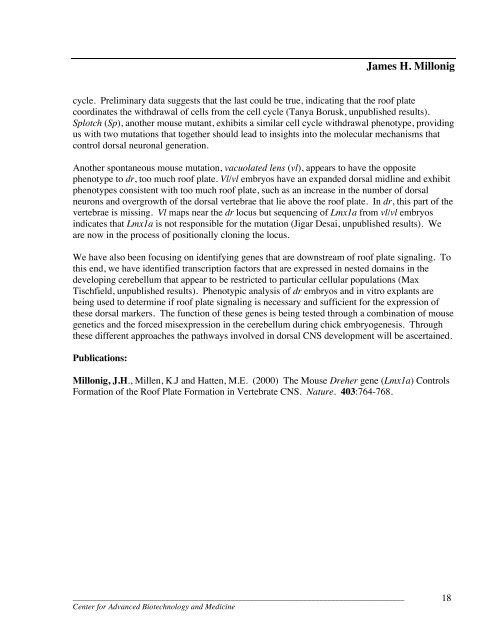2001 - Center for Advanced Biotechnology and Medicine - Rutgers ...
2001 - Center for Advanced Biotechnology and Medicine - Rutgers ...
2001 - Center for Advanced Biotechnology and Medicine - Rutgers ...
Create successful ePaper yourself
Turn your PDF publications into a flip-book with our unique Google optimized e-Paper software.
__________________________________________________________________________________<br />
<strong>Center</strong> <strong>for</strong> <strong>Advanced</strong> <strong>Biotechnology</strong> <strong>and</strong> <strong>Medicine</strong><br />
James H. Millonig<br />
cycle. Preliminary data suggests that the last could be true, indicating that the roof plate<br />
coordinates the withdrawal of cells from the cell cycle (Tanya Borusk, unpublished results).<br />
Splotch (Sp), another mouse mutant, exhibits a similar cell cycle withdrawal phenotype, providing<br />
us with two mutations that together should lead to insights into the molecular mechanisms that<br />
control dorsal neuronal generation.<br />
Another spontaneous mouse mutation, vacuolated lens (vl), appears to have the opposite<br />
phenotype to dr, too much roof plate. Vl/vl embryos have an exp<strong>and</strong>ed dorsal midline <strong>and</strong> exhibit<br />
phenotypes consistent with too much roof plate, such as an increase in the number of dorsal<br />
neurons <strong>and</strong> overgrowth of the dorsal vertebrae that lie above the roof plate. In dr, this part of the<br />
vertebrae is missing. Vl maps near the dr locus but sequencing of Lmx1a from vl/vl embryos<br />
indicates that Lmx1a is not responsible <strong>for</strong> the mutation (Jigar Desai, unpublished results). We<br />
are now in the process of positionally cloning the locus.<br />
We have also been focusing on identifying genes that are downstream of roof plate signaling. To<br />
this end, we have identified transcription factors that are expressed in nested domains in the<br />
developing cerebellum that appear to be restricted to particular cellular populations (Max<br />
Tischfield, unpublished results). Phenotypic analysis of dr embryos <strong>and</strong> in vitro explants are<br />
being used to determine if roof plate signaling is necessary <strong>and</strong> sufficient <strong>for</strong> the expression of<br />
these dorsal markers. The function of these genes is being tested through a combination of mouse<br />
genetics <strong>and</strong> the <strong>for</strong>ced misexpression in the cerebellum during chick embryogenesis. Through<br />
these different approaches the pathways involved in dorsal CNS development will be ascertained.<br />
Publications:<br />
Millonig, J.H., Millen, K.J <strong>and</strong> Hatten, M.E. (2000) The Mouse Dreher gene (Lmx1a) Controls<br />
Formation of the Roof Plate Formation in Vertebrate CNS. Nature. 403:764-768.<br />
18



